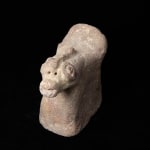Syro Hittite Ram, 2500-1500 BC
Terracotta
20 x 23 x 10 cm
7 7/8 x 9 1/8 x 4 in
7 7/8 x 9 1/8 x 4 in
CB.950
This stylised terracotta sculpture is in the form of a ram with large forward curling horns, a rounded nose and two small holes for eyes. This ram belonged to the...
This stylised terracotta sculpture is in the form of a ram with large forward curling horns, a rounded nose and two small holes for eyes. This ram belonged to the powerful Hittite culture that settled in Anatolia from Asia. These cultures, which were settling in different territories, made small pieces that they could move with them.
The term Syro-Hittite refers to the Aramaic and Phoenician communities of southern Anatolia and northern Syria that came under Hittite rule in the mid-second millennium BCE. The Hittites are mentioned frequently in the Old Testament, but were otherwise unknown to history until archaeologists in the late 19th century began unearthing evidence of a vast, powerful Hittite Empire that flourished between 2,000 BCE and the "great collapse" of circa 1180 BCE.
Small terracotta figures representing both domestic and wild animals, as well as human forms, have been unearthed in great numbers along the western Fertile Crescent. They may have been intended as toys, or as votive objects to be placed in shrines, or both. Serpent and dragon deities featured strongly in the mythology of the Hittites, a major power in ancient Anatolia, while the ram was a popular sacrificial animal across many cultures, including the early Judean. Both animals feature in Genesis, the serpent in the Garden of Eden, and the ram as a substitute sacrifice for Abraham's son Isaac.
The term Syro-Hittite refers to the Aramaic and Phoenician communities of southern Anatolia and northern Syria that came under Hittite rule in the mid-second millennium BCE. The Hittites are mentioned frequently in the Old Testament, but were otherwise unknown to history until archaeologists in the late 19th century began unearthing evidence of a vast, powerful Hittite Empire that flourished between 2,000 BCE and the "great collapse" of circa 1180 BCE.
Small terracotta figures representing both domestic and wild animals, as well as human forms, have been unearthed in great numbers along the western Fertile Crescent. They may have been intended as toys, or as votive objects to be placed in shrines, or both. Serpent and dragon deities featured strongly in the mythology of the Hittites, a major power in ancient Anatolia, while the ram was a popular sacrificial animal across many cultures, including the early Judean. Both animals feature in Genesis, the serpent in the Garden of Eden, and the ram as a substitute sacrifice for Abraham's son Isaac.



